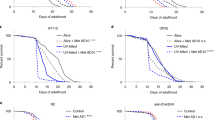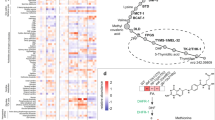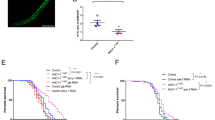Abstract
Studies on aging have centered on two molecular pathways: CDK4/6 and insulin/mTORC1. These pathways are thought to influence aging through distinct mechanisms: mTORC1 by reprogramming systemic metabolism, and CDK4 through p16-mediated senescence and inflammatory signaling (SASP). Here, we investigate the connection between aging and CDK4 in Caenorhabditis elegans, an organism lacking both p16 and SASP. Using a conditional degradation system, we demonstrate that CDK-4 inhibition in C. elegans phenocopies its aging-related functions observed in mammals. Worms with depleted CDK-4 exhibited accelerated aging phenotypes, including reduced lifespan, decreased motility, increased yolk accumulation, and earlier onset of senescence. At the physiological level, CDK4-inhibited worms show substantial metabolic shifts; including enhanced protein synthesis, elevated ATP production, and increased fat accumulation. These metabo-aging phenotypes occur independently of mTORC1, instead operating through the canonical CDK-4 effectors LIN-35 (Rb) and EFL-1 (E2F).
This is a preview of subscription content, access via your institution
Access options
Subscribe to this journal
Receive 12 print issues and online access
$259.00 per year
only $21.58 per issue
Buy this article
- Purchase on SpringerLink
- Instant access to full article PDF
Prices may be subject to local taxes which are calculated during checkout







Similar content being viewed by others
References
Andersen JS et al. (2005) Nucleolar proteome dynamics. Nature 433(7021):77–83. https://doi.org/10.1038/nature03207
Annicotte J-S et al. (2009) The CDK4–pRB–E2F1 pathway controls insulin secretion. Nat Cell Biol 11(8):1017–1023. https://doi.org/10.1038/ncb1915
Anzi S et al. (2018) Postnatal exocrine pancreas growth by cellular hypertrophy correlates with a shorter lifespan in mammals. Dev Cell 45(6):726–737.e3. https://doi.org/10.1016/j.devcel.2018.05.024
Arnold A et al. (2014) Functional characterization of C. elegans Y-box-binding proteins reveals tissue-specific functions and a critical role in the formation of polysomes. Nucleic Acids Res 42(21):13353–13369. https://doi.org/10.1093/nar/gku1077
Baechle JJ et al. (2023) Chronic inflammation and the hallmarks of aging. Mol Metab 74:101755. https://doi.org/10.1016/j.molmet.2023.101755
Baker DJ et al. (2016) Naturally occurring p16Ink4a-positive cells shorten healthy lifespan. Nature 530(7589):184–189. https://doi.org/10.1038/nature16932
Blackwell TK et al. (2019) TOR signaling in Caenorhabditis elegans development, metabolism, and aging. Genetics 213(2):329–360. https://doi.org/10.1534/genetics.119.302504
Blanchet E et al. (2011) E2F transcription factor-1 regulates oxidative metabolism. Nat Cell Biol 13(9):1146–1152. https://doi.org/10.1038/ncb2309
Boisvert F-M et al. (2007) The multifunctional nucleolus. Nat Rev Mol Cell Biol 8(7):574–585. https://doi.org/10.1038/nrm2184
Boulon S et al. (2010) The nucleolus under stress. Mol Cell 40(2):216–227. https://doi.org/10.1016/j.molcel.2010.09.024
Boxem M, van den Heuvel S (2001) lin-35 Rb and cki-1 Cip/Kip cooperate in developmental regulation of G1 progression in C. elegans. Development 128(21):4349–4359. https://doi.org/10.1242/dev.128.21.4349
Buchwalter A, Hetzer MW (2017) Nucleolar expansion and elevated protein translation in premature aging. Nat Commun 8(1):328. https://doi.org/10.1038/s41467-017-00322-z
Buck SH, Chiu D, Saito RM (2009) The cyclin-dependent kinase inhibitors, cki-1 and cki-2, act in overlapping but distinct pathways to control cell-cycle quiescence during C. elegans development. Cell Cycle 8(16):2613–2620
Ceol CJ, Horvitz HR (2001) dpl-1 DP and efl-1 E2F act with lin-35 Rb to antagonize Ras signaling in C. elegans vulval development. Mol Cell 7(3):461–473
Childs BG et al. (2015) Cellular senescence in aging and age-related disease: from mechanisms to therapy. Nat Med 21(12):1424–1435. https://doi.org/10.1038/nm.4000
Dall KB, Færgeman NJ (2019) Metabolic regulation of lifespan from a C. elegans perspective. Genes Nutr 14(1):25. https://doi.org/10.1186/s12263-019-0650-x
Denechaud P-D et al. (2016) E2F1 mediates sustained lipogenesis and contributes to hepatic steatosis. J Clin Investig 126(1):137–150. https://doi.org/10.1172/JCI81542
Dmitrieva NI, Burg MB (2007) High NaCl promotes cellular senescence. Cell Cycle 6(24):3108–3113. https://doi.org/10.4161/cc.6.24.5084
Dottermusch M et al. (2016) Cell cycle controls stress response and longevity in C. elegans. Aging 8(9):2100–2115. https://doi.org/10.18632/aging.101052
Duong T et al. (2020) The Rheb-TORC1 signaling axis functions as a developmental checkpoint. Development 147(5):dev181727. https://doi.org/10.1242/dev.181727
Eroglu M, Yu B, Derry WB (2023) ‘Efficient CRISPR/Cas9 mediated large insertions using long single-stranded oligonucleotide donors in C. elegans. FEBS J 290(18):4429–4439. https://doi.org/10.1111/febs.16876
Escorcia W et al. (2018) Quantification of Lipid Abundance and Evaluation of Lipid Distribution in Caenorhabditis elegans by Nile Red and Oil Red O Staining. J Vis Exp, 133 Available at: https://doi.org/10.3791/57352.
Ewen ME et al. (1993) Functional interactions of the retinoblastoma protein with mammalian D-type cyclins. Cell 73(3):487–497. https://doi.org/10.1016/0092-8674(93)90136-E
Fisher AL (2004) Of worms and women: sarcopenia and its role in disability and mortality. J Am Geriatrics Soc 52(7):1185–1190. https://doi.org/10.1111/j.1532-5415.2004.52320.x
Frottin F et al. (2019) The nucleolus functions as a phase-separated protein quality control compartment. Science 365(6451):342–347. https://doi.org/10.1126/science.aaw9157
Gems D et al. (1998) Two pleiotropic classes of daf-2 mutation affect larval arrest, adult behavior, reproduction and longevity in Caenorhabditis elegans. Genetics 150(1):129–155. https://doi.org/10.1093/genetics/150.1.129
Ginzberg MB et al. (2018) Cell size sensing in animal cells coordinates anabolic growth rates and cell cycle progression to maintain cell size uniformity. eLife 7:e26957. https://doi.org/10.7554/eLife.26957
Hansen M et al. (2007) Lifespan extension by conditions that inhibit translation in Caenorhabditis elegans. Aging Cell 6(1):95–110. https://doi.org/10.1111/j.1474-9726.2006.00267.x
Helman A et al. (2016) p16(Ink4a)-induced senescence of pancreatic beta cells enhances insulin secretion. Na Med 22(4):412–420. https://doi.org/10.1038/nm.4054
Hernandez-Segura A et al. (2017) Unmasking transcriptional heterogeneity in senescent cells. Current Biol CB 27(17):2652–2660.e4. https://doi.org/10.1016/j.cub.2017.07.033
Herndon LA et al. (2002) Stochastic and genetic factors influence tissue-specific decline in ageing C. elegans. Nature 419(6909):808–814. https://doi.org/10.1038/nature01135
Hofmann JW et al. (2015) Reduced expression of MYC increases longevity and enhances healthspan. Cell 160(3):477–488. https://doi.org/10.1016/j.cell.2014.12.016
Hong Y, Roy R, Ambros V (1998) Developmental regulation of a cyclin-dependent kinase inhibitor controls postembryonic cell cycle progression in Caenorhabditis elegans. Development 125(18):3585–3597. https://doi.org/10.1242/dev.125.18.3585
Hope IA (1991) Promoter trapping” in Caenorhabditis elegans. Development 113(2):399–408.
Huang C, Xiong C, Kornfeld K (2004) Measurements of age-related changes of physiological processes that predict lifespan of Caenorhabditis elegans. Proc Natl Acad Sci USA 101(21):8084–8089. https://doi.org/10.1073/pnas.0400848101
Huang W et al. (2022) Cellular senescence: the good, the bad and the unknown. Nat Rev Nephrol 18(10):611–627. https://doi.org/10.1038/s41581-022-00601-z
Kern CC et al. (2023) C. elegans ageing is accelerated by a self-destructive reproductive programme. Nat Commun 14(1):4381. https://doi.org/10.1038/s41467-023-40088-1
Kim HS, Pickering AM (2023) Protein translation paradox: Implications in translational regulation of aging. Front Cell Dev Biol 11, Available at: https://www.frontiersin.org/articles/10.3389/fcell.2023.1129281 (Accessed: 14 August 2023)
Kimura KD et al. (1997) daf-2, an insulin receptor-like gene that regulates longevity and diapause in Caenorhabditis elegans. Science 277(5328):942–946. https://doi.org/10.1126/science.277.5328.942
Kominsky DJ, Campbell EL, Colgan SP (2010) Metabolic shifts in immunity and inflammation. J Immunol 184(8):4062–4068. https://doi.org/10.4049/jimmunol.0903002
Krishnamurthy J et al. (2006) p16INK4a induces an age-dependent decline in islet regenerative potential. Nature 443(7110):453–457. https://doi.org/10.1038/nature05092
Kumari R, Jat P (2021) Mechanisms of cellular senescence: cell cycle arrest and senescence associated secretory phenotype. Front Cell Dev Biol. 9. Available at: https://www.frontiersin.org/articles/10.3389/fcell.2021.645593 (Accessed: 1 November 2023)
Lagido C et al. (2008) Bridging the phenotypic gap: Real-time assessment of mitochondrial function and metabolism of the nematode Caenorhabditis elegans. BMC Physiol 8(1):7. https://doi.org/10.1186/1472-6793-8-7
Lakowski B, Hekimi S (1998) The genetics of caloric restriction in Caenorhabditis elegans. Proc Natl Acad Sci USA 95(22):13091–13096
Lees JA et al. (1993) The retinoblastoma protein binds to a family of E2F transcription factors. Mol Cell Biol 13(12):7813–7825. https://doi.org/10.1128/mcb.13.12.7813-7825.1993
Liu GY, Sabatini DM (2020) mTOR at the nexus of nutrition, growth, ageing and disease. Nat Rev Mol Cell Biol 21(4):183–203. https://doi.org/10.1038/s41580-019-0199-y
Lu X, Horvitz HR (1998) lin-35 and lin-53, two genes that antagonize a C. elegans Ras pathway, encode proteins similar to Rb and its binding protein RbAp48. Cell 95(7):981–991
Mandigo AC et al. (2021) RB/E2F1 as a master regulator of cancer cell metabolism in advanced disease. Cancer Discov 11(9):2334–2353. https://doi.org/10.1158/2159-8290.CD-20-1114
Martínez-Carreres L et al. (2019) CDK4 regulates lysosomal function and mTORC1 activation to promote cancer cell survival. Cancer Res 79(20):5245–5259. https://doi.org/10.1158/0008-5472.CAN-19-0708
Martinez-Miguel VE et al. (2021) Increased fidelity of protein synthesis extends lifespan. Cell Metab 33(11):2288–2300.e12. https://doi.org/10.1016/j.cmet.2021.08.017
Olmedo M et al. (2015) A high-throughput method for the analysis of larval developmental phenotypes in Caenorhabditis elegans. Genetics 201(2):443–448. https://doi.org/10.1534/genetics.115.179242
O’Rourke EJ et al. (2009) C. elegans major fats are stored in vesicles distinct from lysosome-related organelles. Cell Metab 10(5):430–435. https://doi.org/10.1016/j.cmet.2009.10.002
Papadopoli D et al. (2019) mTOR as a central regulator of lifespan and aging. F1000Research 8:Rev-998. https://doi.org/10.12688/f1000research.17196.1
Patra KC, Bardeesy N (2018) A cell size theory of aging. Dev Cell 45(6):665–666. https://doi.org/10.1016/j.devcel.2018.06.001
Perez MF, Lehner B (2019) Vitellogenins - yolk gene function and regulation in Caenorhabditis elegans. Front Physiol 10:1067. https://doi.org/10.3389/fphys.2019.01067
Porstmann T et al. (2008) SREBP activity is regulated by mTORC1 and contributes to akt-dependent cell growth. Cell Metab 8(3–3):224–236. https://doi.org/10.1016/j.cmet.2008.07.007
Rayess H, Wang MB, Srivatsan ES (2012) Cellular senescence and tumor suppressor gene p16. Int J Cancer J Int du Cancer 130(8):1715. https://doi.org/10.1002/ijc.27316
Romero-Pozuelo J et al. (2020) Cdk4 and Cdk6 couple the cell-cycle machinery to cell growth via mTORC1. Cell Rep 31(2):107504. https://doi.org/10.1016/j.celrep.2020.03.068
Schertel C, Conradt B (2007) C. elegans orthologs of components of the RB tumor suppressor complex have distinct pro-apoptotic functions. Development 134(20):3691–3701. https://doi.org/10.1242/dev.004606
Seah NE et al. (2016) Autophagy-mediated longevity is modulated by lipoprotein biogenesis. Autophagy 12(2):261–272. https://doi.org/10.1080/15548627.2015.1127464
Sherr CJ, Roberts JM (1999) CDK inhibitors: positive and negative regulators of G1-phase progression. Genes Dev 13(12):1501–1512. https://doi.org/10.1101/gad.13.12.1501
Sulston JE, Horvitz HR (1977) Post-embryonic cell lineages of the nematode, Caenorhabditis elegans. Dev Biol 56(1):110–156. https://doi.org/10.1016/0012-1606(77)90158-0
Tan C et al. (2021) Cell size homeostasis is maintained by CDK4-dependent activation of p38 MAPK. Dev Cell 56(12):1756–1769.e7. https://doi.org/10.1016/j.devcel.2021.04.030
Tiku V et al. (2017) Small nucleoli are a cellular hallmark of longevity. Nat Commun 8(1):1–9. https://doi.org/10.1038/ncomms16083
Tsang CK et al. (2003) Chromatin-mediated regulation of nucleolar structure and RNA Pol I localization by TOR. EMBO J 22(22):6045–6056. https://doi.org/10.1093/emboj/cdg578
Wiley CD, Campisi J (2021) The metabolic roots of senescence: mechanisms and opportunities for intervention. Nat Metab 3(10):1290–1301. https://doi.org/10.1038/s42255-021-00483-8
Winn J et al. (2011) Hox and a newly identified E2F co-repress cell death in Caenorhabditis elegans. Genetics 188(4):897–905. https://doi.org/10.1534/genetics.111.128421
Yesbolatova A et al. (2020) The auxin-inducible degron 2 technology provides sharp degradation control in yeast, mammalian cells, and mice. Nat Commun 11(1):5701. https://doi.org/10.1038/s41467-020-19532-z
Zhou KI, Pincus Z, Slack FJ (2011) Longevity and stress in Caenorhabditis elegans. Aging 3(8):733–753
Acknowledgements
This work was supported by a Canadian Institutes of Health Research Project grant to WBD. (PJT 165837). WBD is the Canada Research Chair in Animal Models of Human Disease.
Author information
Authors and Affiliations
Contributions
Conceptualization: RW, WBD, RK. Methodology: RW, WBD, RK. Investigation: RW. Visualization: RW. Funding acquisition: WBD. Supervision: WBD, RK. Writing – original draft: RW. Writing – review & editing: RW, WBD, RK.
Corresponding authors
Ethics declarations
Competing interests
The authors declare no competing interests.
Ethics
No ethics approvals are required for research using Caenorhabditis elegans in Canada. All experiments were performed in accordance with the relevant guidelines and regulations.
Additional information
Publisher’s note Springer Nature remains neutral with regard to jurisdictional claims in published maps and institutional affiliations.
Associate editor: Alper Akay
Supplementary information
Rights and permissions
Springer Nature or its licensor (e.g. a society or other partner) holds exclusive rights to this article under a publishing agreement with the author(s) or other rightsholder(s); author self-archiving of the accepted manuscript version of this article is solely governed by the terms of such publishing agreement and applicable law.
About this article
Cite this article
Webster, R., Quintana, M., Yu, B. et al. CDK-4 regulates nucleolar size and metabolism at the cost of late-life fitness in C. elegans. Heredity (2025). https://doi.org/10.1038/s41437-025-00769-7
Received:
Revised:
Accepted:
Published:
DOI: https://doi.org/10.1038/s41437-025-00769-7



